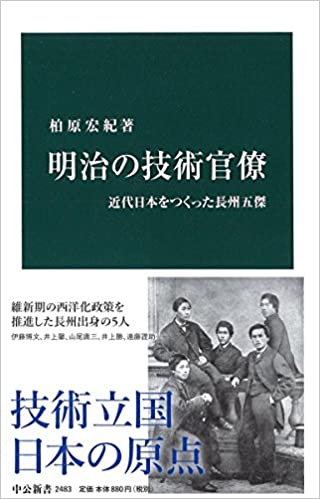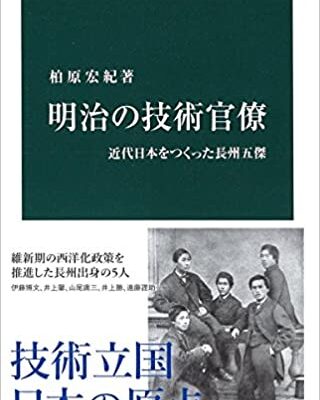柏原宏紀 著「明治の技術官僚 近代日本をつくった長州五傑」中公新書
日本で勉強する留学生に、地域の近代化について話をするように依頼がありました。そのため、大阪や神戸の明治以降の近代化を調べている中、たくさんの外国人が御雇外国人として雇われていたことを知ると共に、その御雇外国人から学んだ、あるいは彼らと共に働くなかで専門能力を高めていき、それぞれの分野をリードするまでになった日本人たちの姿がありました。今回は、その時に読んだ本です。
この本の長州五傑とは、伊藤博文、井上薫、山尾庸三、井上勝、遠藤勤助です。ともにイギリス留学をして、それぞれの人生、政治家あるいは官僚の道を歩みます。まあ、具体的な記述については、本書をお読みください。ここでは、通訳ガイドとして、日本の近代化に関して、知っておいたらと思うトピックスを紹介します。
御雇外国人について、給料はどの程度だったでしょうか。本書での具体的な金額が明治されています。引用すると「例えば、明治2年(1869)11月に決定を見た鉄道建設では、政府トップの給料と同じ月給800円のイギリス人建築師長エドモンド・モレル以下、多数の技術者を西洋諸国から雇用し、資材も外国から購入しなければならなかった。」とあります。(元々の出典は、山田直匡『お雇い外国人4 交通』)
また、当時の政府高官よりも高い給料をもらっていた外国人もいました。引用すると。「太政大臣の月給が800円の時代に、鉄道差配役カーギルは2,000円、建築師長ボイルは1,250円と、それを上回る額が支給され」ていました。(元々の出典は、『工部省沿革報告』)。
鉄道のケースで、日本への技術導入について考えると、明治初頭は、御雇外国人が複数名招かれる中で、日本人で留学経験のあるものが彼らと共に活躍をしました。次に、明治10年前後では、御雇外国人から独立して海外でより専門知識を学んできた日本の技術官僚を中心に政策が進められたそうです。また、明治20年代になると、日本国内で専門教育を受けた世代が活躍するようになりました。そうれでも、新技術のほとんどが西洋のものでしたから、技術官僚が専門性を磨くには海外調査が必要でありました。
他の分野でも、概ね同じような経過を経て、西洋の技術を日本に導入してきたようです。それぞれ関心のある分野を調べるのも面白いと思います。(完)

明治の技術官僚 近代日本をつくった長州五傑 (中公新書) [ 柏原 宏紀 ]
価格:968円
(2021/5/30 21:36時点)
感想(0件)
“Meiji no Gijutsu Kanryo (The five outstanding Choshu bureaucrats who created modern Japan),” by Hiroki Kashiwabara, Chuko Shinsho
I was asked to give a talk on the modernization of the region to foreign students studying in Japan. While researching the modernization of Osaka and Kobe after the Meiji period, I learned that many foreigners were employed as “Oyatoi Gaikokujin” (hired foreigners), and I also learned about Japanese people who learned from or worked with these foreigners and developed their professional skills, becoming leaders in their respective fields. This time, I would like to share with you a book I read at that time.
The five Choshu greats in this book are Hirobumi Ito, Kaoru Inoue, Yozo Yamao, Masaru Inoue, and Kinsuke Endo. They studied in England and went on to their respective lives, politicians or bureaucrats. Well, please read this book for specific descriptions. As an interpreter/guide, here are some topics that I think you should know about the modernization of Japan.
How much was the salary for foreigners hired by the government? The specific amounts in this book are given in the Meiji era. For example, the construction of the railroad, which saw a decision made in November 1869, required the hiring of a number of engineers from Western countries and the purchase of materials from abroad, including Edmund Morrell, a British master builder whose monthly salary was 800 yen, the same as the salary of the head of the government. ((The original source is Naomasa Yamada, “Ohayo Gaikokujin 4 Kotsu”)(The original source is Naomasa Yamada, “Ohayo Gaikokujin 4 Kotsu”)
There were also foreigners who were paid higher salaries than government executive officials of the time. There were also foreigners who were paid higher salaries than government officials of the time. To quote. In an era when the monthly salary of the Minister of Grand Council of State was 800 yen, Cargill, the railroad difference officer, was paid 2,000 yen, and Boyle, the chief building engineer, was paid 1,250 yen, and more than that.” (The original source is “History Report of the Ministry of Works”).
Considering the introduction of technology to Japan in the case of the railroads, at the beginning of the Meiji period, while several foreign employees were invited to Japan, Japanese who had studied abroad played an active role along with them. Next, around the 10th year of Meiji, the policy was promoted mainly by Japanese technical bureaucrats who had studied abroad for more specialized knowledge independently of the hired foreigners. In the 1887s, the generation that had received specialized education in Japan began to take an active role. Even so, since most of the new technologies were from the West, the technical bureaucrats needed to conduct overseas research to hone their expertise.
It seems that other fields have also introduced Western technology to Japan through a similar process. It would be interesting to investigate each field of interest. (End)
“Meiji no Gijutsu Kanryo (Les cinq remarquables bureaucrates de Choshu qui ont créé le Japon moderne),” par Hiroki Kashiwabara, Chuko Shinsho
On m’a demandé de donner une conférence sur la modernisation de la région à des étudiants étrangers qui étudient au Japon. En faisant des recherches sur la modernisation d’Osaka et de Kobe après la période Meiji, j’ai appris que de nombreux étrangers étaient employés en tant que “Oyatoi Gaikokujin” (étrangers engagés), et j’ai également appris que des Japonais avaient appris de ces étrangers ou avaient travaillé avec eux et avaient développé leurs compétences professionnelles, devenant ainsi des leaders dans leurs domaines respectifs. Cette fois, j’aimerais partager avec vous un livre que j’ai lu à l’époque.
Les cinq grands de la Choshu présentés dans ce livre sont Hirobumi Ito, Kaoru Inoue, Yozo Yamao, Masaru Inoue et Kinsuke Endo. Ils ont étudié en Angleterre et ont poursuivi leur vie respective, politiciens ou bureaucrates. Veuillez lire ce livre pour des descriptions précises. En tant qu’interprète/guide, voici quelques sujets que vous devriez connaître sur la modernisation du Japon.
Quel était le salaire des étrangers engagés par le gouvernement ? Les montants spécifiques indiqués dans ce livre sont ceux de l’ère Meiji. Par exemple, la construction du chemin de fer, dont la décision a été prise en novembre 1869, a nécessité l’embauche d’un certain nombre d’ingénieurs de pays occidentaux et l’achat de matériaux à l’étranger, dont Edmund Morrell, un maître d’œuvre britannique dont le salaire mensuel était de 800 yens, soit le même que le salaire du chef du gouvernement. ((La source originale est Naomasa Yamada, “Ohayo Gaikokujin 4 Kotsu”)(La source originale est Naomasa Yamada, “Ohayo Gaikokujin 4 Kotsu”)
Il y avait aussi des étrangers qui recevaient des salaires plus élevés que les fonctionnaires de l’époque. Il y avait également des étrangers qui recevaient des salaires plus élevés que les fonctionnaires du gouvernement de l’époque. Je cite. À une époque où le salaire mensuel du ministre du Grand Conseil d’État était de 800 yens, Cargill, le responsable des différences entre les chemins de fer, était payé 2 000 yens, et Boyle, l’ingénieur en chef des bâtiments, était payé 1 250 yens, et plus encore.” (La source originale est “History Report of the Ministry of Works”).
Si l’on considère l’introduction de la technologie au Japon dans le cas des chemins de fer, au début de la période Meiji, alors que plusieurs employés étrangers étaient invités au Japon, les Japonais qui avaient étudié à l’étranger jouaient un rôle actif à leurs côtés. Ensuite, vers la dixième année de Meiji, la politique a été promue principalement par des bureaucrates techniques japonais qui avaient étudié à l’étranger pour acquérir des connaissances plus spécialisées, indépendamment des étrangers engagés. Dans les années 1887, la génération qui avait reçu une éducation spécialisée au Japon a commencé à jouer un rôle actif. Néanmoins, comme la plupart des nouvelles technologies venaient de l’Ouest, les bureaucrates techniques devaient mener des recherches à l’étranger pour affiner leur expertise.
Il semble que d’autres domaines aient également introduit la technologie occidentale au Japon par le biais d’un processus similaire. Il serait intéressant d’étudier chaque domaine concerné. (Fin)
